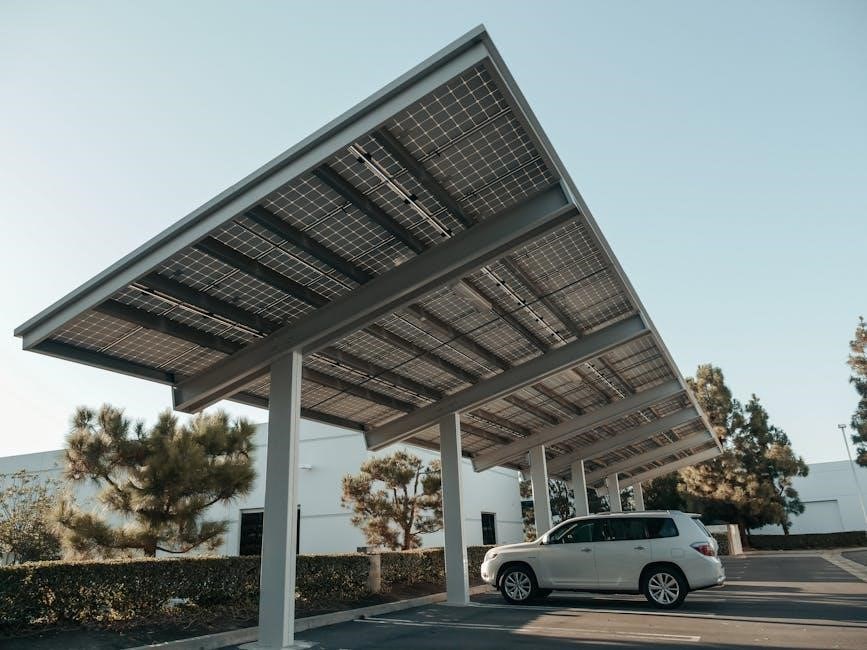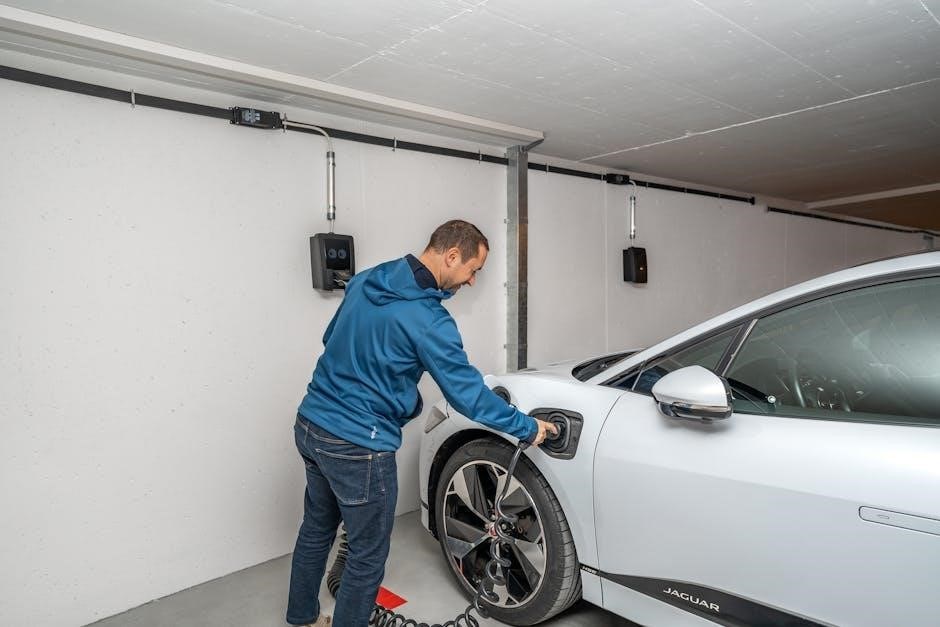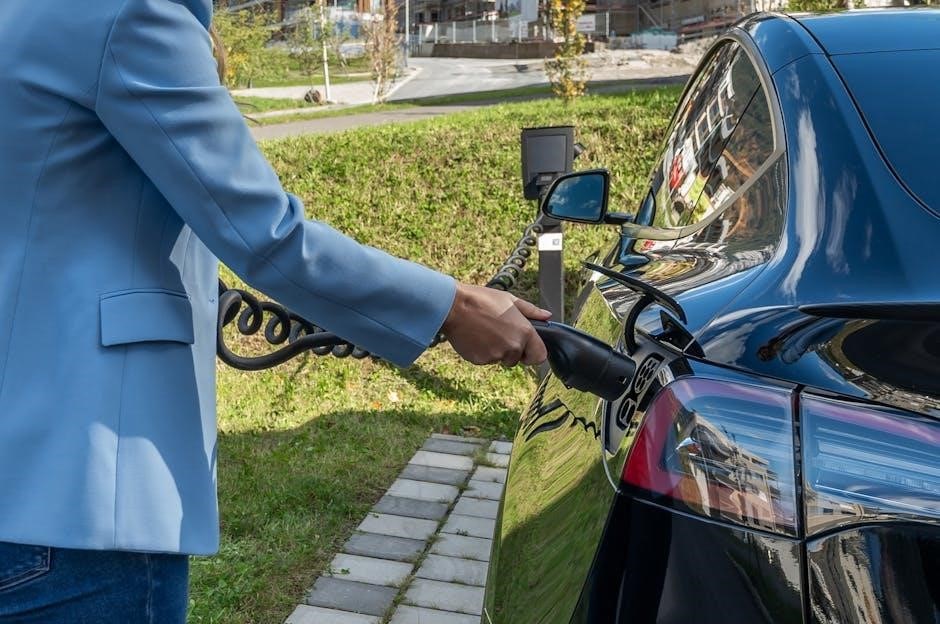Removing Trojan T-1275 batteries requires careful attention to safety and procedure, especially within a Sol-Ark system. Understanding voltage differences
and load priority settings is crucial for a successful and safe disconnection process.
Proper removal ensures optimal performance and longevity of your power setup, whether it’s a golf cart or a larger DIY solar installation.
Understanding the T-1275 Battery
The Trojan T-1275 is a 12-volt deep-cycle battery, specifically designed for demanding applications like golf carts and off-grid solar systems. Unlike starter batteries, it excels at sustained discharge, boasting a 150 amp-hour capacity at a 20-hour rate;
This means it can consistently deliver 7.5 amps for 20 hours before needing recharge. Recognizing its deep-cycle nature is vital when assessing lifespan and potential failure signs during removal and replacement.
Safety Precautions Before Removal
Prior to removing Trojan T-1275 batteries, disconnect the load circuit to eliminate any drain during the process, as seen in Sol-Ark systems. Always wear appropriate safety gear, including gloves and eye protection, when handling lead-acid batteries.
Be mindful of potential voltage differences between batteries and avoid short circuits. Document battery positions for correct reconnection, and work in a well-ventilated area.

Tools Required for Battery Removal
Essential tools include wrenches for terminals, a multimeter for voltage checks, safety glasses, and gloves. Having these readily available streamlines the removal process effectively.
Essential Hand Tools
For safe and efficient removal, you’ll need a socket wrench set, specifically sizes to fit the battery terminal bolts. Adjustable wrenches are also helpful for varied connections. A ratchet with extensions provides access to tight spaces. Insulated screwdrivers are vital for disconnecting wiring, preventing shorts. Pliers can assist with cable management, and a battery terminal cleaner ensures good contact upon reinstallation.
Safety Gear
Prioritize safety with essential gear. Always wear safety glasses to protect your eyes from acid splashes or debris. Chemical-resistant gloves are crucial when handling batteries, preventing burns. An apron or old clothing shields your skin from potential spills. Ensure adequate ventilation, as batteries release hydrogen gas. Have baking soda nearby to neutralize any acid contact.
Step-by-Step Removal Process
Begin by disconnecting the load circuit to prevent battery drain during removal. Identify and carefully disconnect the negative terminals first, followed by the positive terminals.
Disconnecting the Load Circuit
Before initiating battery removal, completely disconnect the load circuit from the Sol-Ark system. This prevents any parasitic drain on the batteries while they are disconnected and ensures a safe working environment.
As noted in DIY Solar Power Forum discussions, disconnecting the load allows the batteries to charge optimally when the PV array is active, maximizing their potential before removal.
Identifying Battery Terminals
Accurately identify the positive and negative terminals on each Trojan T-1275 battery within the series-parallel configuration. Incorrect identification can lead to short circuits or damage to the Sol-Ark system.
Carefully trace the cabling to confirm polarity, especially in a system where batteries are connected in both series and parallel arrangements, as described in golf cart replacement guides.
Removing Negative Terminals First
Always disconnect the negative terminals from each Trojan T-1275 battery before addressing the positive terminals. This crucial step minimizes the risk of accidental short circuits during the removal process.
Removing the negative connection first breaks the circuit, preventing sparks and potential damage to the Sol-Ark system or connected components, as emphasized in safety guides.
Disconnecting Positive Terminals
After safely removing all negative terminals, proceed to disconnect the positive terminals from each Trojan T-1275 battery. Ensure tools are insulated and movements are deliberate to avoid any accidental contact.
Complete disconnection of both positive and negative sides isolates the battery bank, preparing it for inspection, testing, or replacement, as detailed in golf cart battery guides.

Voltage Considerations During Removal
Monitoring voltage differences between batteries is vital during removal, especially in series-parallel configurations like a Sol-Ark 12k system with T-1275s.
Load priority settings impact readings, so disconnect the load circuit first for accurate assessment.
Observing Voltage Differences
Significant voltage variations among Trojan T-1275 batteries, ranging from 13.42V to 14.46V, indicate potential imbalances within the bank. These discrepancies can arise from differing charge/discharge cycles or internal resistance variations.
Documenting each battery’s voltage before disconnection is crucial for identifying weaker cells. This data helps determine if individual batteries require specific attention or replacement, ensuring optimal system performance.
Impact of Load Priority Settings
When utilizing a Sol-Ark system with “load priority” enabled, the PV array directly powers loads, minimizing battery discharge. Disconnecting the load circuit before battery removal is vital to prevent unexpected power loss or surges during the process.
Confirming load priority is active ensures batteries aren’t unnecessarily strained while disconnecting, preserving their charge and simplifying the removal procedure.
Battery Inspection and Testing
Thoroughly inspect each T-1275 for physical damage and assess its lifespan. Look for bulging, cracks, or corrosion, indicating potential failure and requiring immediate attention.
Checking for Physical Damage
Visually examine each Trojan T-1275 battery for any signs of physical distress. Look closely for cracks in the casing, bulging sides, or deformation, which can indicate internal issues. Inspect the terminals for corrosion, a white or bluish buildup, and check for any leaks of electrolyte solution.
Carefully note any damage, as it suggests the battery may be compromised and unsafe for continued use, potentially impacting the entire system’s performance.
Assessing Battery Lifespan
Evaluate the age of each Trojan T-1275 battery; deep-cycle batteries have a limited lifespan, typically 3-5 years with regular use. Consider the frequency and depth of discharge cycles – deeper discharges shorten lifespan. Observe performance; a noticeable decrease in runtime indicates declining capacity.
Remember that the T-1275 boasts 150 amp-hours, but diminished capacity signals it’s nearing the end of its useful life and requires replacement.
Recognizing Signs of Battery Failure
Identify a battery that consistently reads lower voltage than others during testing, as seen in Sol-Ark systems (13.42v vs 14.46v). Look for physical damage like cracks or bulging cases. Notice excessive corrosion around terminals, hindering performance.
Pay attention to a battery that fails to hold a charge or exhibits a rapid self-discharge, indicating internal issues and the need for immediate replacement.

Deep Cycle Battery Characteristics
Trojan T-1275 batteries are deep-cycle, designed for sustained discharge unlike starter batteries. They boast a 150 amp-hour capacity, delivering 7.5 amps for 20 hours.
Understanding Deep Cycle vs. Starter Batteries
Deep-cycle batteries, like the Trojan T-1275, excel at providing consistent power over extended periods, ideal for applications like golf carts and solar energy storage.
Conversely, starter batteries deliver short, powerful bursts to initiate engines. Deep-cycle batteries tolerate repeated discharging and recharging cycles without significant degradation, while starter batteries suffer damage from deep discharges.
Choosing the correct battery type is vital for optimal performance and longevity.
T-1275 Battery Capacity (150 Amp-Hours)
The Trojan T-1275 battery boasts a substantial 150 amp-hour capacity at a 20-hour rate, meaning it can consistently deliver 7.5 amps for twenty hours before needing a recharge.
This high capacity makes it well-suited for demanding applications requiring sustained power, such as powering loads in a Sol-Ark system or providing extended runtime for electric vehicles.
Understanding this capacity is key to proper system design and usage.

Golf Cart Battery Replacement Specifics
Reconnect batteries in a series/parallel configuration, ensuring correct polarity. After reconnection, verify proper operation by listening for the reverse buzzer functionality, confirming a successful swap.
Reconnect Batteries in Series/Parallel
To restore power, carefully reconnect the batteries following the original series/parallel configuration. Begin with the final negative terminal, then proceed systematically, connecting each battery in turn. Ensure all connections are secure and corrosion-free for optimal conductivity.
Maintain consistent polarity throughout the process, and double-check each connection before proceeding to the next, preventing potential damage or system malfunction.
Final Checks After Reconnection
Post-reconnection, flip the Run/Tow switch back to “Run” and turn the key to verify proper operation. Listen attentively for the reverse buzzer, a key indicator of correct functionality. Confirm voltage readings across the battery bank are consistent and within expected parameters.
Thorough testing ensures a smooth transition and confirms the system is operating safely and efficiently after the battery replacement process.

Battery Repair Options
Battery repair liquids, like Battery Fixer, offer a potential solution to extend battery life, though limitations exist. Repair isn’t always feasible or cost-effective.
Battery Additives and Repair Liquids
Certain products, such as two-part battery additives like Battery Fixer available on eBay, claim to rejuvenate sulfated lead-acid batteries. These liquids aim to dissolve sulfate crystals, potentially restoring capacity.
However, the effectiveness varies greatly depending on the battery’s condition and the extent of sulfation; severely damaged batteries may not respond. Consider these as a possible, but not guaranteed, solution.
Limitations of Battery Repair
While battery additives offer a potential fix, they have significant limitations. Severely damaged cells, physical breaks within the battery, or permanent plate corrosion cannot be reversed with repair liquids.
These products primarily address sulfation, and won’t restore a battery with internal shorts or significant capacity loss. Replacement often proves more cost-effective long-term.

Troubleshooting Common Issues
If no power appears after reconnection, double-check all connections. A functioning reverse buzzer indicates proper operation, confirming successful battery replacement and system setup.
No Power After Reconnection
Experiencing a complete lack of power following the reconnection of your Trojan T-1275 batteries demands a systematic approach. Begin by meticulously re-examining every terminal connection, ensuring they are clean, tight, and free from corrosion. Verify the Run/Tow switch is in the ‘Run’ position.
Confirm the Sol-Ark system is correctly configured for battery operation and isn’t solely relying on PV input. A thorough check of all wiring is essential for restoring power.
Reverse Buzzer Functionality
A functioning reverse buzzer is a positive indicator of a successful reconnection of your Trojan T-1275 battery bank. Upon turning the key, listen attentively for the distinct buzzing sound when the golf cart is shifted into reverse. This confirms the control system is receiving power
and operating correctly. Absence of the buzzer suggests a wiring issue or a problem with the reverse switch itself, requiring further investigation.

Battery Maintenance Tips
Regular voltage monitoring and proper charging practices are vital for maximizing the lifespan of your Trojan T-1275 batteries. Consistent upkeep ensures optimal performance.
Proper Charging Practices
Maintaining optimal charge levels is paramount for Trojan T-1275 longevity; Avoid undercharging, as it leads to sulfation, reducing capacity. Full, yet not excessive, charging is ideal.
Utilize a quality charger designed for deep-cycle batteries, and follow the manufacturer’s recommendations. Equalization charges periodically can help balance cell voltages and extend battery life significantly.
Regular Voltage Monitoring
Consistent voltage checks are vital for identifying potential issues early. Monitor each battery individually, noting significant deviations – as seen in Sol-Ark systems (13.42v to 14.46v range).
Record readings to track performance trends. Low voltages indicate discharge or a failing cell, while high voltages may suggest overcharging. Proactive monitoring prevents unexpected failures.
Disposal of Old Batteries
Proper battery disposal is essential for environmental responsibility. Recycling options are readily available, preventing harmful materials from entering landfills and protecting our planet.
Environmental Considerations
Lead-acid batteries like the T-1275 contain hazardous materials, demanding responsible disposal practices. Improper handling can lead to soil and water contamination, posing significant risks to ecosystems and human health. Recycling recovers valuable materials, reducing the need for new resource extraction.
Prioritizing environmentally sound disposal methods safeguards our planet and complies with environmental regulations, ensuring a sustainable future for all.
Recycling Options
Numerous options exist for recycling Trojan T-1275 batteries, preventing environmental harm. Local auto parts stores, battery retailers, and recycling centers often accept lead-acid batteries for recycling, sometimes offering core deposits. Specialized battery recycling facilities process these batteries, recovering lead, plastic, and acid.
Check with your municipality for local collection events or drop-off locations, ensuring responsible battery disposal.

Sol-Ark System Considerations
Sol-Ark systems display varying battery voltages during operation; disconnecting the load circuit is vital before removal. Monitor readings closely, as load priority impacts voltage.
Voltage Readings in Sol-Ark Systems
Within a Sol-Ark 12k system utilizing eight Trojan T-1275 batteries in a series-parallel 48v configuration, expect voltage discrepancies between individual batteries. Reported readings range from 13.42v to 14.46v.
These variations are normal, especially after disconnecting and reconnecting the load circuit, and while the PV array is simultaneously charging the battery bank under load priority settings.
Load Circuit Impact on Battery Voltage
Disconnecting the load circuit initially prevents battery drain, allowing new batteries to charge fully when solar power is available. Reconnecting the load circuit, with the Sol-Ark on load priority, means the PV array powers loads directly.
Consequently, no power is drawn from the battery bank during peak sun hours, influencing voltage readings and potentially causing observed differences between individual batteries.

Alternative Battery Technologies
Lithium battery conversions, like those from MANLY, present a viable alternative to Trojan T-1275s, offering increased energy density and lifespan for your system.
Lithium Battery Conversions
Switching to lithium batteries from Trojan T-1275s involves significant benefits, including lighter weight, higher energy density, and extended cycle life. However, careful consideration is needed regarding compatibility with your Sol-Ark system.
Lithium requires a different charging profile and Battery Management System (BMS) integration. MANLY batteries are often cited as a potential replacement, but professional consultation is recommended to ensure a safe and efficient conversion.
MANLY Battery as an Alternative
MANLY batteries present a compelling alternative to Trojan T-1275s, offering increased lifespan and reduced weight for your golf cart or solar setup. They are frequently discussed in DIY solar forums as a viable lithium conversion option.
However, ensure compatibility with your Sol-Ark system and understand the necessary BMS integration for safe and optimal charging. Proper voltage and current settings are vital for maximizing MANLY battery performance.
Resources and Further Information
For detailed guidance, explore DIY Solar Power Forums and Tara Electric Vehicles’ information. These platforms offer valuable insights and community support for battery maintenance.
DIY Solar Power Forums
Online forums dedicated to DIY solar power, like the one mentioned regarding Sol-Ark systems and T-1275 batteries, are invaluable resources. Users share experiences with voltage discrepancies, load circuit impacts, and successful battery removal techniques.
These communities provide practical advice, troubleshooting assistance, and a platform to discuss specific challenges encountered during the process, fostering collaborative learning.
Tara Electric Vehicles Information
Tara Electric Vehicles highlights the importance of understanding deep-cycle batteries like the Trojan T-1275, differing from starter batteries in their sustained discharge capability. Knowing the T-1275’s 150 amp-hour capacity aids in assessing lifespan and recognizing failure signs.
This knowledge is crucial for informed removal and replacement, ensuring compatibility and optimal performance in electric vehicle applications.
Successfully removing and replacing Trojan T-1275 batteries demands meticulous attention to safety protocols, voltage considerations, and proper reconnection procedures. Addressing potential issues like reverse buzzer functionality and ensuring correct series/parallel configurations are vital.
Prioritizing maintenance and responsible disposal completes the process, maximizing system efficiency and environmental responsibility.
